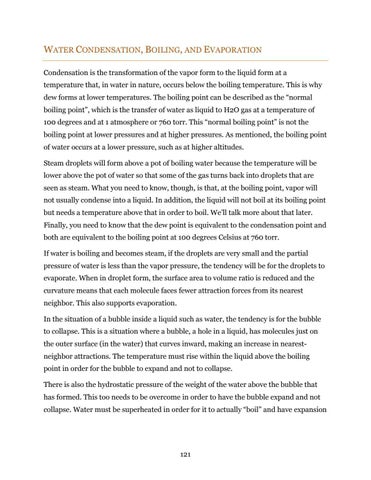WATER CONDENSATION, BOILING, AND EVAPORATION Condensation is the transformation of the vapor form to the liquid form at a temperature that, in water in nature, occurs below the boiling temperature. This is why dew forms at lower temperatures. The boiling point can be described as the “normal boiling point”, which is the transfer of water as liquid to H2O gas at a temperature of 100 degrees and at 1 atmosphere or 760 torr. This “normal boiling point” is not the boiling point at lower pressures and at higher pressures. As mentioned, the boiling point of water occurs at a lower pressure, such as at higher altitudes. Steam droplets will form above a pot of boiling water because the temperature will be lower above the pot of water so that some of the gas turns back into droplets that are seen as steam. What you need to know, though, is that, at the boiling point, vapor will not usually condense into a liquid. In addition, the liquid will not boil at its boiling point but needs a temperature above that in order to boil. We’ll talk more about that later. Finally, you need to know that the dew point is equivalent to the condensation point and both are equivalent to the boiling point at 100 degrees Celsius at 760 torr. If water is boiling and becomes steam, if the droplets are very small and the partial pressure of water is less than the vapor pressure, the tendency will be for the droplets to evaporate. When in droplet form, the surface area to volume ratio is reduced and the curvature means that each molecule faces fewer attraction forces from its nearest neighbor. This also supports evaporation. In the situation of a bubble inside a liquid such as water, the tendency is for the bubble to collapse. This is a situation where a bubble, a hole in a liquid, has molecules just on the outer surface (in the water) that curves inward, making an increase in nearestneighbor attractions. The temperature must rise within the liquid above the boiling point in order for the bubble to expand and not to collapse. There is also the hydrostatic pressure of the weight of the water above the bubble that has formed. This too needs to be overcome in order to have the bubble expand and not collapse. Water must be superheated in order for it to actually “boil” and have expansion
121




























